Iteration 14, lockdown special
March 2022
This iteration started as a lockdown project, as a reason to get into the makeshift kitchen table studios we set up during the late 2021 lockdown. Highly accessible yet fractured, compromised spaces of making that reflected our scattered and deformed plans.
When long days stretched into longer days, when everything was dim and formless in the ever-extending lockdown, the project was realised because a kernel of reason was in need. A reason, or simply an invitation to make - for ourselves and ultimately for each other. The project concept provided an important alternative strategy for art-making when everything was suspended and submerged. Gift, reciprocity and connection; the demoted and misplaced reasons became the cornerstone of making as our regular dominant economies and demanding schedules dissolved.
11 artists each made a series of 11 (or 12 for symmetry) small works to split up and gift to each other after lockdown.
The promise of a future encounter - a lipstick kiss on the calendar, to summon, whenever needed - it was there.
It has to be said, that when we came to install the work talking about lockdown projects was tiring … once relevant, but we had moved on right? or at least we wanted to. Yet, as it happened, by the time these images and words were ready to share the Omicron variant was peaking and we were recovering in isolation, clocking up another 10 days at the kitchen table.
Text by Nat Tozer
Michelle Reid, Inga Fillary, Ekaterina Dimieva, Tori Beech, Sue Nelson, Janet Mazenier, Karen Rubado, Jana Wood, Veronica Herber, Lucy Boermans and Nat Tozer
All images by Stephen Robinson

MICHELLE REID ‘Quiet Evolution’, #1-11, Watercolour on Paper, 200 x 300 mm each
These watercolours are my playful exploration in organic reformation. I made peace with my weeds while slowing down at home, observing how plant life continues to persist through a multitude of environmental changes on small and large scales.
Curiosity in what could become of future biological forms in unknowable conditions led me to recompose elements of Ernst Haeckel’s 1800’s microscopic organisms.
The making of these gifts offered me an alternative space to wander, finding a calm and meaningful way to process these things we are living through.
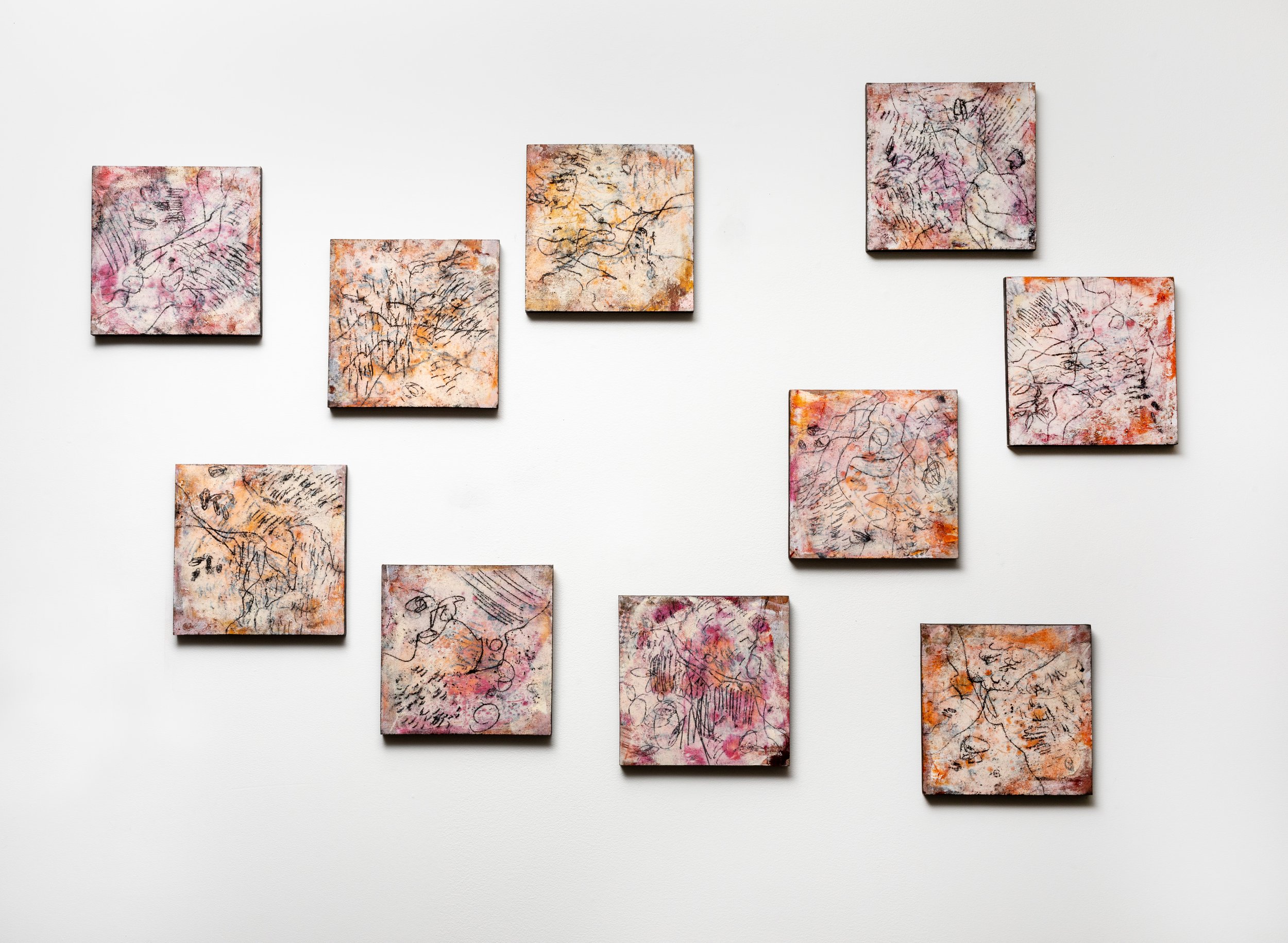
JANET MAZENIER. 'Walking the Dog' series, Dry pigment, charcoal, oil paint and local sourced cold beeswax medium, 2021. My practice is fundamentally about drawing. A surface offers a realm of infinite, different temporal and spatial dimensions to construct compositions. I take information from the world and out of this create other possible worlds - drawn marks, brushstrokes, a flick of solvent and/or a raw, felt line all accrete to a final work. My discovery process starts with my daily walks, and the observations made of the micro-worlds uncovered by my dog as we pause to sniff, look and inhale. The globes of a seaweed necklace, twigs, pine-needles, broken asphalt, detritus, grass blades, weeds, organic, mulch matter become the subject-matter for my work.
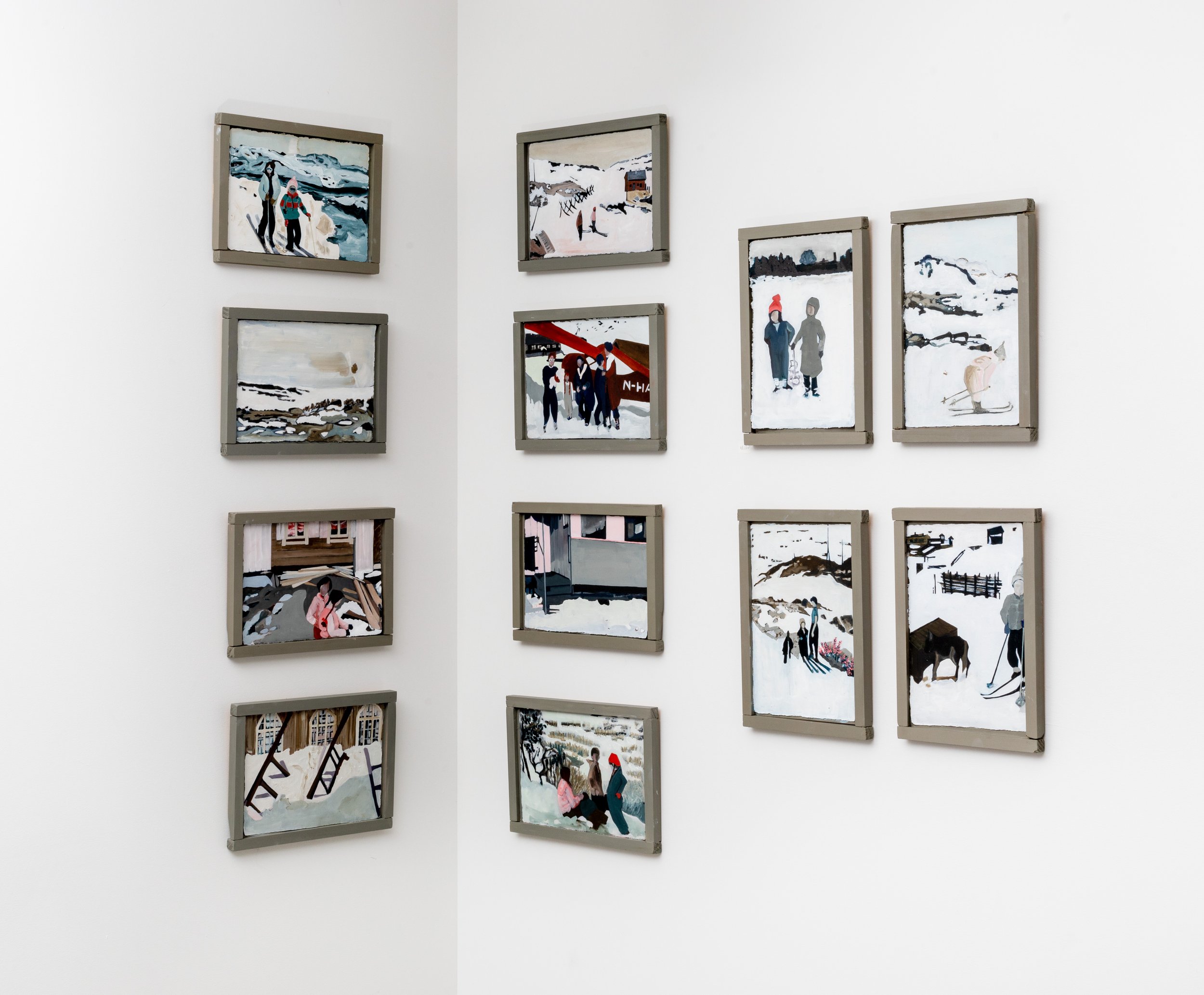
TORI BEECHE. 'Holocene Days' Series. Oil Paint, 340 x 235mm, 2021 The series I made for the mothermother special lockdown project is called Holocene Days. The title is a mash-up of the idiom ‘Halcyon Days’, which refers to a period of calm, and nostalgic reflection on past happiness and contentment; and the ‘Holocene Epoch’ our current period of geologic time. The Holocene has been one of Earth's most stable epochs, providing favourable conditions for humans to flourish. The origin of the descriptor Halcyon Days is Greek legend, it was used to signify the fourteen days of calm around the winter solstice. A time when gods calmed the sea for nesting and hatching. According to current scientific opinion we are about to enter a new geological age and the Holocene, a period of 10,000 years during which the average global temperature has not waivered up or down by more than one degree Celsius, is finished. What will winter playtime look like in the future?

VERONICA HERBER. Alongside installations Herber has developed a quieter practice utilizing Japanese Washi tape on paper. These works are made from hand torn pieces of Japanese Washi Foto tape with a minimalist leaning, revolving around the structure of the grid. Being in Covid lockdown solo for 3 months created a curious relationship with time. Time became drawn out and developed a sticky liquorice type quality making creativity thick and languorous. In lucid moments, I would clutch some clarity and work sharply before sinking back into a weird lethargic state. The swap series gave me an impetuous to produce spontaneously with the hope my art practice base would propel me forward. These works are an expression of fleeting moments of light.
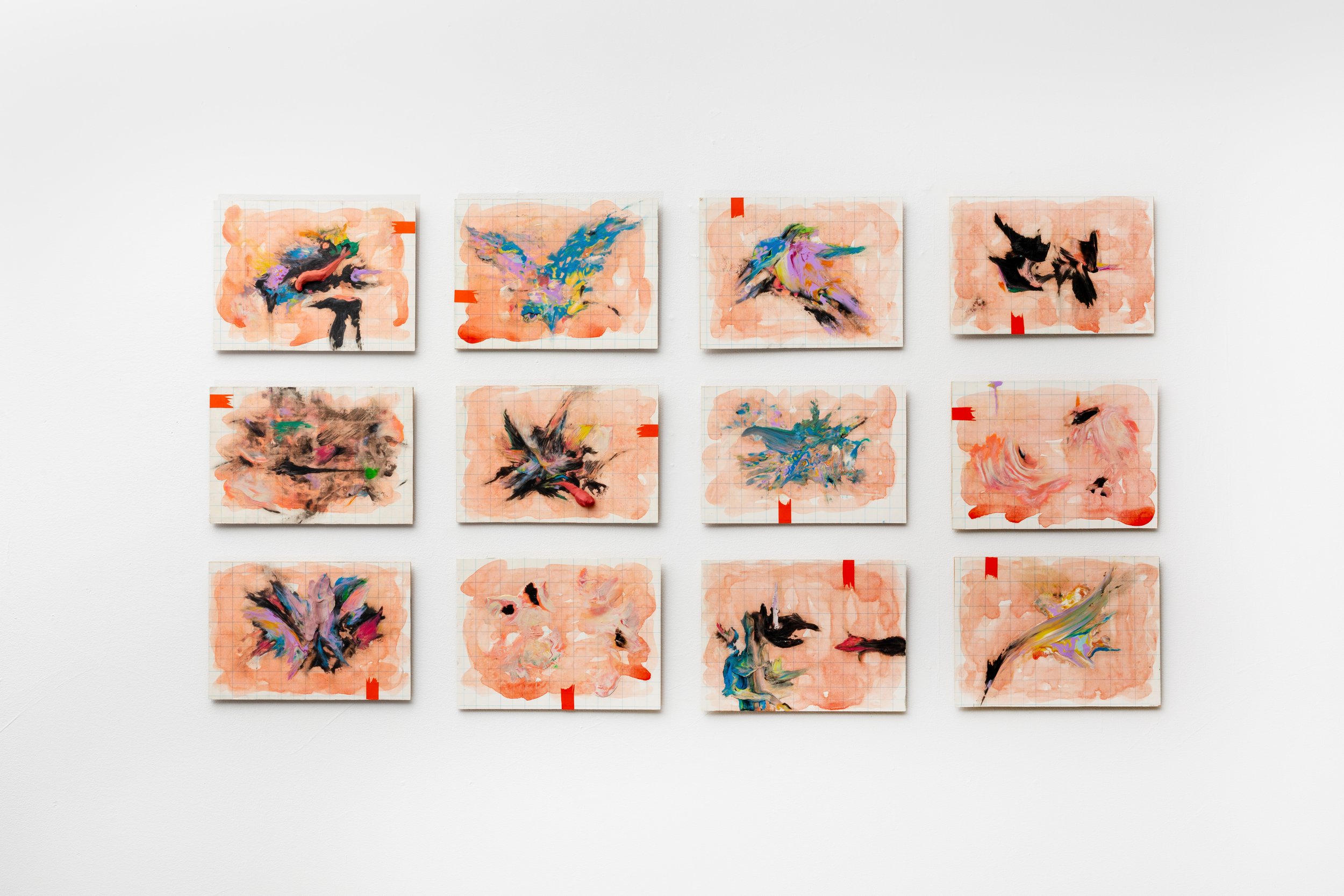
SUSAN NELSON ‘Studies in plasticine 12’, paper, watercolour, and plasticine. Studies in Plasticine 12 became a very tactile painting-slash-drawing exercise whereby modeling clay was smeared, scraped, built up and sliced back, revealing coloured layers and unexpected designs. It started with a base of old-school paper grid lines that were begging to be interrupted, first by soft puddles of watercolour, and further by a riot of obnoxious chaos. Clearly a release for pent up frustration, disappointment and anxiety during a time of epic patience and lack of control.
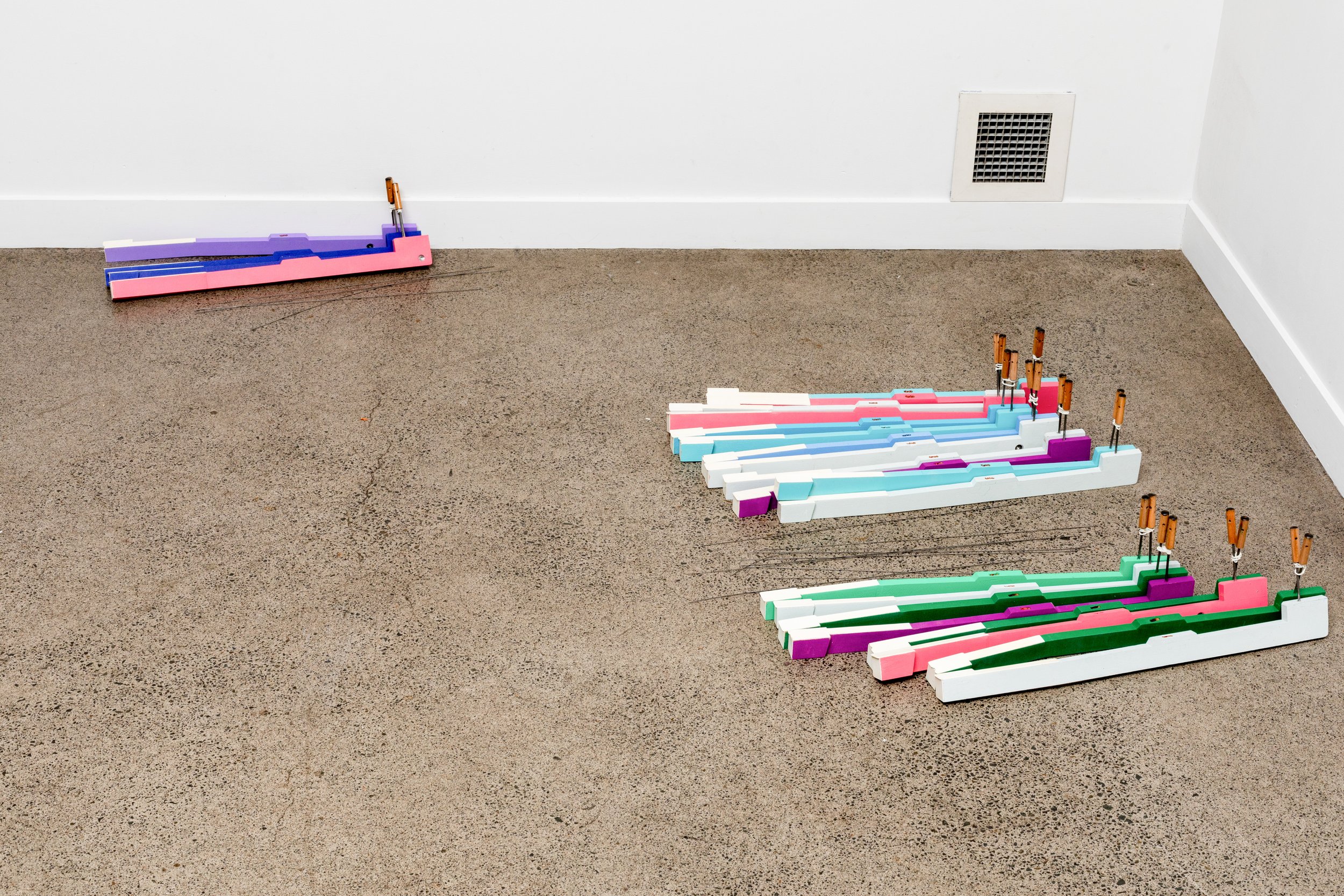
LUCY BOERMANS, ‘Two for you: a new life shared’, painted pianola keys, 2021.
Over a period of months (how many, I can’t be sure) potential deconstruction methods ranged from, dropping from a great height, to setting alight, to the sledgehammer approach. Lockdown revealed an uncanny surfacing of slow-drifting and active-frustration events that ultimately, led to a desire to deconstruct, then reconstruct, rather than destroy.
With an invitation from mothermother, to create a “swap-series”, well, there it was, the old pianola, appearing on every opening of the garage door, obtained for an artwork and performance that never was, the defiant object had to be shared.
After the momentous build up, dismantling the pianola took a matter of hours - though the keys stayed in place for months, they were the last to go.
Once extracted like teeth from a gaping hole, they lay in jumbled piles, moving from table to table, lost, around the house, annoying the family for months, whilst colour swatches were matched from a gesture-exchange, video-edit timeline, tight clips stacked, in sequence.
It makes sense to give them as a series-in-pairs. They are a new life shared.

KAREN RUBADO, ‘Lifeline’, paper, wool, wire, found objects, 2021. Lockdown tried to take my energy, ambition and most distressingly, my creativity, but the project came to my rescue. With whatever was in the house (magazines, old frames, recycled yarns, and wire) the work began ever so slowly and experimentally. With time, it evolved and it transformed into something greater, planting precious seeds along the way.
This series was first and foremost about making without judgement with the purpose of generating ideas. Each piece informed the next so they are all linked by a progression of techniques, mistakes, and observations. It is an ever expanding investigation that has launched larger and more ambitious works.

NAT TOZER, pyrex molded foil and concrete, iridescent acrylic, 2022.

JANA WOOD, 'The Views from the Dunes', 2021 / 2022. Oil on wood panel. There are many ‘views’ to be found at Port Waikato. These particular works were made mostly in the late afternoon during early to mid Spring. We had been in Lockdown for about a month, and the sand-dunes came alive with a pallette of wildflowers, a special kind of energy pervading the resting land, with a backdrop of incredible skies. It was a time of rest, and energy all at once, both stirring and hopeful in these unprecedented times of turmoil. This gift-giving project has been abundant in good feelings of connection with both land and people. The act of giving has a strong indigenous history, acknowledging both our surroundings and our connection to each other, helping to ensure harmonious co-existence, and ensuring we live in a world of relations.

INGA FILLARY, 'Communion', 2022. These little tactile works are all about the senses and the sensual quality of the materials. They are made of unadulterated clay collected from various parts of the North Island. The tondo substrates are painted in acrylics. I have made them with my hands, no brushes or other tools between the materials and I, as Kazuo Shiraga said “shaking hands with the materials,” as one might shake hands with a friend. They carry the hint of an influence of Duchamp’s Rotoreliefs (1935) with their incursion of a dense, somatic pressure. Until I experienced creating these works I disagreed with Rosalind Krauss’ assertions that the Rotoreliefs pulse “with erotic suggestiveness” but curiously now after having become so intimate with them I can see and feel it too. So I present a small and intimate collection of works to my small and intimate group of friends, thank you for being there xxx
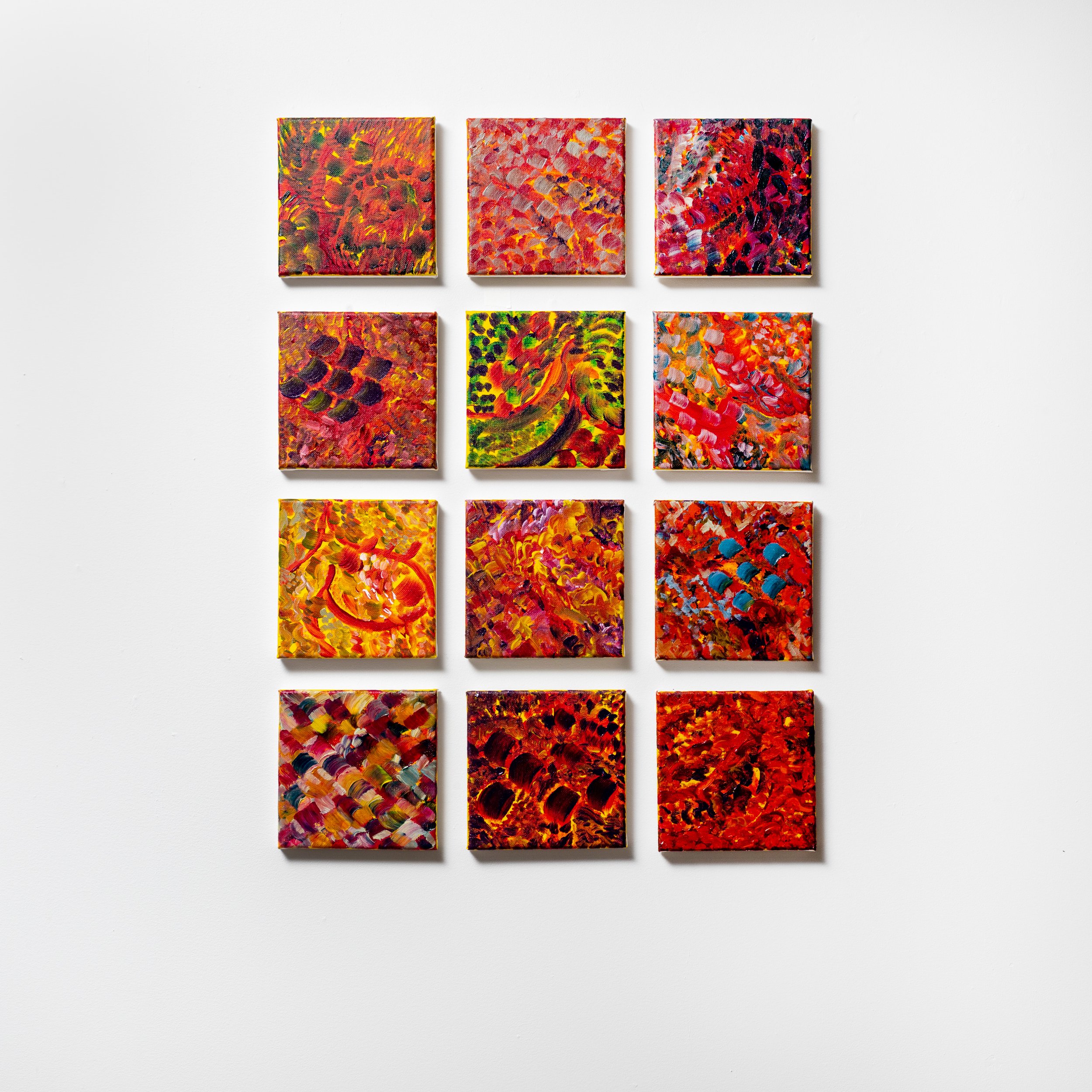
EKATERINA DIMIEVA. 'Everything has to be an experiment, otherwise it’s dead..' Maggie Hambling How do you paint energy? Is it with lines? Or dots? Or swarms of brushmarks? These small studies ask this simple question. The eternal exchange of energies penetrating & percolating around, through, and within us - never resting, forever switching, morphing, changing.
ARTISTS
Michelle Reid
Michelle Reid is an artist living in Riverhead, Auckland. She graduated with a Bachelor of Textile Design from Massey in 2001, and in 2019 gained a Postgraduate Diploma from Elam School of Fine Arts with Distinction. In 2017 she received a Highly Commended at Molly Morpeth Canaday Award in Whakatane, and was the Corbans Looking West Winner in 2016. Reid was a finalist in New Zealand Painting and Printmaking Award in 2019 and her artworks are held in contemporary private collections in Auckland. An eclectic mix of written, visual, and intuition, inform her painting practise which has grown out of atmosphere aesthetics theories. Ideas are currently being drawn out of Romanticism; nature’s regrowth in the post-human landscape; and optimism, patterning, and ‘Accidentism’ theories of Joseph Frank. Reid’s artworks are made with watercolour on paper and oil washes on reassembled canvas off-cuts. Recent exhibitions include ‘Resist’ at Allpress Studio (2021), ‘Alienation’ with Nomadic Art Gallery (2020), ‘Atmospheric Disquiet’ at Elam Grad Show (2019).
Tori Beeche
Tori Beeche lives and works in Tamaki Makaurau, New Zealand. She graduated in 2015 from the University of Auckland’s Elam School of Fine Arts with a BFA (First Class Honours) and gained her MFA (First Class Honours) in 2020. Her work has been included in the finalist exhibitions for the Molly Morpeth Canaday Award (2021), New Zealand Painting & Printmaking Award (2020), and the Sunshine Coast Art Prize (2018). Recent exhibitions include Caught Up In Circles at Föenander Galleries (2021), Auckland Spaces of Synchronicity at Malcolm Smith Gallery, Auckland (2021) and RESIST at Allpress Studio Gallery, Auckland (2021). Tori’s paintings are formed through a process of extracting poetic moments from historical archives and encoding them with an alternative reality, asking viewers to consider the value of nostalgic reflection.
Jana Wood
Jana Wood works from her studio at Putataka, Port Waikato. Her art practice seeks to develop a deep engagement with the whenua/land that surrounds her. Jana has always been drawn to the West Coast, with it’s particular colour, temperature, smell, light, it’s aliveness and wildness is what attracts her to live and work there. Jana is of mixed heritage, Maori (Ngati Raukawa/Ngati Kikopiri) and Scottish (Clan McKay). She graduated from AUT with a Bachelor of Visual Arts in 2015, and did further study at ELAM graduating with a PgDipFa in 2018. Recent shows include Three Painters, McLeavey Gallery, National Contemporary Art Award, Waikato Museum, Molly Morpeth Canaday Art Awards, Te Koputu a Te Whanga a Toi, Whakatane Library and Arts Centre, and A’float, Arthaus Contemporary, Orakei. Jana’s work is held in private collections both in NZ and overseas, including The James Wallace collection.
Susan Nelson
Susan Nelson (she/her) is a multi-media visual artist based in Tāmaki Makaurau (Auckland), Aotearoa (New Zealand). Her practice is centred around authentic creative process and discovering the unconscious through playful exploration of a wide range of materials spanning from bronze, plasticine, wax, and clay to yarn, paper, and hard candy 2D and 3D sculpture. She has trained at the Valerie Skemp Decorative Arts Studio (Canada), The Vancouver Academy of Art, Otago Polytechnic (Dunedin), and most recently completed a Postgrad Diploma in Fine Arts at Elam, University of Auckland (2020).
Nat Tozer
Nat Tozer is an artist and experimental filmmaker based in Tāmaki Makaurau exploring narratives of the underground to unearth objects and knowledge. Working with time-based processes and materiality across paper, sculpture and video she is interested in mythology, the code of Hammurabi, debt forgiveness, accessing the ground, science fiction and anarchist anthropology.
Recent group shows include National Contemporary Art Award at Waikato Museum, Iteration 10 at Piki Mai: Up Here, Auckland Art Fair for mothermother artist-run gallery, Emerging Artists Show at Sanderson Gallery, Salted Earth at Sosage Gallery and Goofer Dust at Elam Project Space. In 2021 she received the Lightship Award to install a 110m video installation at the Ports of Auckland, was selected as a finalist in the National Contemporary Award and Femisphere 4, and represented Elam School of Fine Arts at the Guangzhou Graduate Art Fair. In 2020 Natalie received a Summer Scholarship from the University of Auckland and PGDipFA with distinction.
Janet Mazenier
Janet Mazenier is an artist based in Tāmaki Makaurau who locates her practice as engaging with the foundational tension in contemporary painting of realism and abstraction. Her work investigates the terrain on which we stand, her complex work declaring its material enquiry and visual language with her chosen media comprising charcoal, dry pigments, oil paint and beeswax medium. This media contributes to what is an inherently experimental approach to each artwork, their material surfaces acting as a kind of portal into the cognitive site of the encounter responsible for their existence.
Recent group shows include the Estuary Art Awards people’s choice (candidate) at Uxbridge, The Places we Tread at Space Gallery, Whanganui, Spaces of Synchronicity, Uxbridge, Is It Real, Is It True, Flagstaff Gallery, Love Your Maunga, Maungauika/North Head, The River Runs Deep, George Fraser Gallery, Auckland. Janet completed her Master of Fine Arts (First Class Hons.) at Elam, University of Auckland in 2021.
Inga Fillary
Fillary’s recent works represent attempts to operationalise the highly abstract theories found in modern philosophy. Low hierarchy substances, and materials disturbed from their former authority are the cornerstone of Fillary’s practice. When utility is removed, objects are freed to become something other, images can be drawn away from fine art media to subtly reposition the way ‘messages’ can be transmitted, the material is very important. Deeper realities that lie beneath the perceivable surfaces emerge and a material ‘life’ is uncovered. Fillary experiments with the onslaught of time on material, she addresses the burden of humankind upon the earth and the possibility of aesthetic experience to provide an oblique approach to a veiled reality.
Inga Fillary holds a Master of Fine Arts with First Class Honours from Elam School of Fine Arts.
Ekaterina Dimieva
Dimieva’s practice explores conflict, interference and the morphing states of transformation. It approaches the notion of painting as a sort of multiple flux. It’s a sense based enquiry that rejects answers in the singular.
Her work strives to embody a rhythmic play of flows and forces, while generating their own multiplicity through the materiality of paint. The focus on sensation and utopia is central to her act of painting, with an emphasis on profusion, abundance and excess - in both the mark-making as well as the persistent use of pattern and the predominant choice of a saturated colour palette. Dimieva achieves a raw complexity to the surface with her wet-in-wet technique that gives way to dry brush staining. The overall effect compels the viewer to search out a potential intent or pattern. Yet, the patterning seems to extend to something off canvas.. discordant and unravelled, it speaks to a different sort of grid or pattern matrix.
Ultimately the work is more like a puzzle, a riddle that celebrates the complex, the evolving, the sensual, and the feminine.
Lucinda Boermans
Lucinda Boermans is an interdisciplinary artist based in East Auckland. Boermans’ practice derives from an interest in movement, embodied experience, language and learning. Central to her practice is research-based enquiry that focuses upon relational aesthetics, affect theory and transformation.
Karen Rubado
Karen Rubado lives and works in Tāmaki Makaurau Auckland. She completed her Master of Fine Arts at the University of Auckland in 2017. Rubado is interested in the aggregation and transformation of found materials through hand-making. Her enthusiasm lies in the connections between intention and action, the real and imagined, and the imperfection that often characterises the handmade. Inspired by techniques of improvisation within a structure, her weaving practice encourages the unexpected and allows for spontaneity as a catalyst for discovery. She sees this as a subtle form of opposition to the authorial powers of tradition and the expectations emanating from both craft and contemporary art conventions.
Rubado was recently commissioned to produce a work for Te Tuhi and was featured as an emerging artist for “Projects” curated by Gabriela Salgado and Francis McWhannell in the 2018 Auckland Art Fair. Recent exhibitions include soft ware at Melanie Roger Gallery in Auckland (2021), 1924 at Corban Estate in Auckland (2021), and Daisy Chain at The Den Project Space in Christchurch (2021).
Veronica Herber
While attending AUT University Herber became fully engaged in contemporary art practice. She moved on from being a painter when she unearthed a desire to work on a larger scale, discovering masking tape as a medium half way through her arts degree.
Over two years of experimentation she fell in love with the immediacy and versatility of the material, culminating in her trademark tape fabric and large-scale outdoor sculpture works. Alongside the installations Herber also developed a quieter practice utilizing Japanese Washi tape on paper.
Her work is included in the Chartwell Collection, Auckland Art Gallery Toi o Tamaki and The James Wallace Arts Trust.
